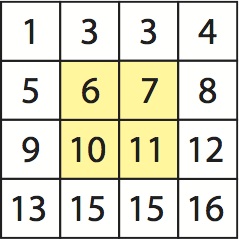Problem 1069
A L-addition consists in the following operation: we choose three squares forming a L (two squares share one of their sides, horizontal for one, vertical for the other, with a third square), then we add 1 to each of the numbers they contain.
For example, in the green grid above, a first L-addition can transform 10, 11 and 7 respectively to 11, 12 and 8. The goal is that all the squares contain the same number, called target number.
- 1. What is the smallest reachable target number starting from the green grid? (7 points)
- 2. Same question for the 4 × 4 grid below. (7 points)

I haven't written a program for this problem.
- 1. 16
- 2. 18